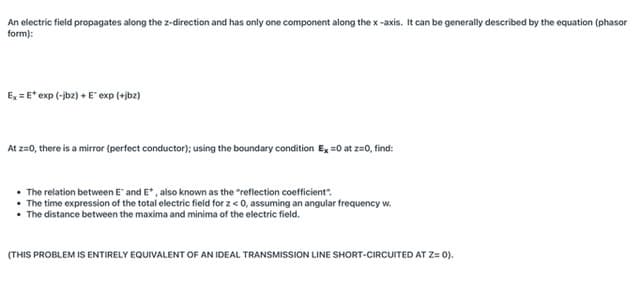An electric field propagates along the z-direction and has only one component along the x -axis. It can be generally described by the equation (phasor form): Ex = E* exp (-jbz) + E" exp (+jbz) At z=0, there is a mirror (perfect conductor); using the boundary condition E, =0 at z=0, find: The relation between E" and E*, also known as the "reflection coefficient". The time expression of the total electric field for z < 0, assuming an angular frequency w. The distance between the maxima and minima of the electric field. (THIS PROBLEM IS ENTIRELY EQUIVALENT OF AN IDEAL TRANSMISSION LINE SHORT-CIRCUITED AT Z= 0).
An electric field propagates along the z-direction and has only one component along the x -axis. It can be generally described by the equation (phasor form): Ex = E* exp (-jbz) + E" exp (+jbz) At z=0, there is a mirror (perfect conductor); using the boundary condition E, =0 at z=0, find: The relation between E" and E*, also known as the "reflection coefficient". The time expression of the total electric field for z < 0, assuming an angular frequency w. The distance between the maxima and minima of the electric field. (THIS PROBLEM IS ENTIRELY EQUIVALENT OF AN IDEAL TRANSMISSION LINE SHORT-CIRCUITED AT Z= 0).
Introductory Circuit Analysis (13th Edition)
13th Edition
ISBN:9780133923605
Author:Robert L. Boylestad
Publisher:Robert L. Boylestad
Chapter1: Introduction
Section: Chapter Questions
Problem 1P: Visit your local library (at school or home) and describe the extent to which it provides literature...
Related questions
Question
100%
Question is under attachment.

Transcribed Image Text:An electric field propagates along the z-direction and has only one component along the x-axis. It can be generally described by the equation (phasor
form):
Ex = E* exp (-jbz) + E" exp (+jbz)
At z=0, there is a mirror (perfect conductor); using the boundary condition Ex =0 at z=0, find:
The relation between E" and E*, also known as the "reflection coefficient".
The time expression of the total electric field for z < 0, assuming an angular frequency w.
• The distance between the maxima and minima of the electric field.
(THIS PROBLEM IS ENTIRELY EQUIVALENT OF AN IDEAL TRANSMISSION LINE SHORT-CIRCUITED AT Z= 0).
Expert Solution
This question has been solved!
Explore an expertly crafted, step-by-step solution for a thorough understanding of key concepts.
This is a popular solution!
Trending now
This is a popular solution!
Step by step
Solved in 3 steps

Knowledge Booster
Learn more about
Need a deep-dive on the concept behind this application? Look no further. Learn more about this topic, electrical-engineering and related others by exploring similar questions and additional content below.Recommended textbooks for you

Introductory Circuit Analysis (13th Edition)
Electrical Engineering
ISBN:
9780133923605
Author:
Robert L. Boylestad
Publisher:
PEARSON

Delmar's Standard Textbook Of Electricity
Electrical Engineering
ISBN:
9781337900348
Author:
Stephen L. Herman
Publisher:
Cengage Learning

Programmable Logic Controllers
Electrical Engineering
ISBN:
9780073373843
Author:
Frank D. Petruzella
Publisher:
McGraw-Hill Education

Introductory Circuit Analysis (13th Edition)
Electrical Engineering
ISBN:
9780133923605
Author:
Robert L. Boylestad
Publisher:
PEARSON

Delmar's Standard Textbook Of Electricity
Electrical Engineering
ISBN:
9781337900348
Author:
Stephen L. Herman
Publisher:
Cengage Learning

Programmable Logic Controllers
Electrical Engineering
ISBN:
9780073373843
Author:
Frank D. Petruzella
Publisher:
McGraw-Hill Education

Fundamentals of Electric Circuits
Electrical Engineering
ISBN:
9780078028229
Author:
Charles K Alexander, Matthew Sadiku
Publisher:
McGraw-Hill Education

Electric Circuits. (11th Edition)
Electrical Engineering
ISBN:
9780134746968
Author:
James W. Nilsson, Susan Riedel
Publisher:
PEARSON

Engineering Electromagnetics
Electrical Engineering
ISBN:
9780078028151
Author:
Hayt, William H. (william Hart), Jr, BUCK, John A.
Publisher:
Mcgraw-hill Education,